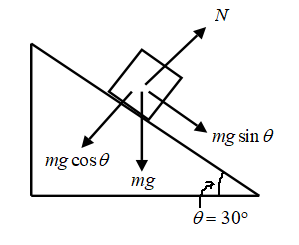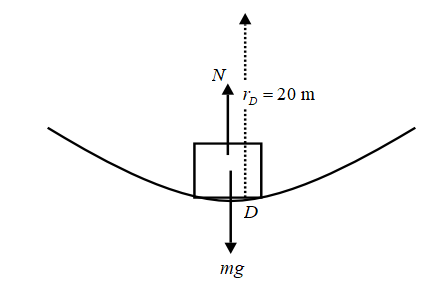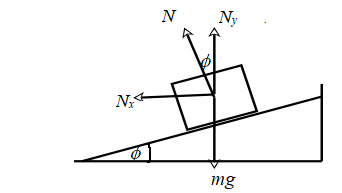
Concept explainers
(a)
The height of point B above the ground, if the car at A barely makes it up the hill at B.
(a)
Answer to Problem 97P
The point B is at a height of
Explanation of Solution
Given:
The mass of the roller- coaster carriage
Speed at point A
Height of A above the ground
Formula used:
The carriage at A has both potential and kinetic energies.
However, the carriage just manages to make it over the point B . This means that at B the carriage has no kinetic energy, it has potential energy alone by virtue of its position.
Therefore, the energy at B is given by,
Apply the law of conservation of energy to the motion of the carriage between points A and B .
Therefore,
Hence,
Calculation:
Substitute the values of the variables in equation (1).
Conclusion:
Thus, the point B is at a height of
(b)
The magnitude of the force exerted by the track on the car if it is just able to make it over the hill at B .
(b)
Answer to Problem 97P
Explanation of Solution
Given:
The mass of the roller- coaster carriage
Radius of curvature of the hill located at B .
Formula used:
The car crosses over a hill of radius of curvature
provides the centripetal force. This is shown in Figure 1, below:

Figure 1
Thus, the force exerted by the track on the car is the centripetal force and this is equal to the weight of the car.
Calculation:
Substitute the given values of the variables in equation (2).
Conclusion:
Thus, the magnitude of the force exerted by the track on the car at point B is found to be
(c)
The acceleration of the car at point C .
(c)
Answer to Problem 97P
Explanation of Solution
Given:
The angle of the incline
Formula used:
The point C is on an incline and when no dissipative forces act on the car, the car moves down with a constant acceleration. Modelling the motion of the car at point C as that over an incline, the free body diagram of the car is drawn.

Figure 2
The car is under the action of two forces: (i) the weight
Since the block is in equilibrium along the direction perpendicular to the incline,
However, the component
Hence,
Calculation:
Substitute the values of the variables in equation (3) and calculate the value of the acceleration at point C .
Conclusion:
Thus, the acceleration of the car at point C is found to be
(d)
The force exerted by the track on the car at point D .
(d)
Answer to Problem 97P
The force exerted by the track on the car at point D is found to be
Explanation of Solution
Given:
The mass of the roller- coaster carriage
Radius of curvature of the valley located at D .
Height of point B above the ground
Formula used:
The point D is located at the ground level. Assuming the car has zero velocity at B , its energy is entirely potential at B . This energy is converted into kinetic energy at D .
Using the law of conservation of energy
At D the car traces an arc of radius

Figure 3
The car is acted upon by two forces- (i) Its weight
The total inward force provides the centripetal force, which is given by the expression
Therefore,
Hence,
From equation (4),
Equation (5), therefore can be simplified as follows:
Therefore,
Calculation:
Substitute the values of the variables in equation (6).
Conclusion:
Thus, the force exerted by the track on the car at point D is found to be
(e)
The magnitude and the direction of the force exerted by the track at the point F which lies in the middle of a banked horizontal curve of radius 30 m.
(e)
Answer to Problem 97P
The magnitude of the force exerted by the track on the car is
Explanation of Solution
Given:
The mass of the roller- coaster carriage
Height of point F above the ground
Radius of curvature of the path at F
Speed at point A
Formula used:
The car is at the same height as point A . The system is under the action of gravitational forces alone. Hence the speed at F is equal to the speed at A .
The car is on a horizontal banked road. The forces acting on the car are shown in Figure 4.

Figure 4
The forces acting on the car are (i) weight
The normal force N is resolved into two components-
The car is in equilibrium along the y direction.
Therefore,
The component
The force exerted by the track on the car is given by,
The angle made by the force N with the horizontal is given by,
Calculation:
Substitute the values of the variables in equation (7) and calculate the value of
Substitute the values of the variables in equation (8) and calculate the value of
Substitute the values of the variables in equation (9) and calculate the magnitude of the force exerted by the track on the car.
Calculate the angle made by the force with the horizontal using equation (10).
Conclusion:
Thus, the magnitude of the force exerted by the track on the car is
(f)
The magnitude of the braking force that needs to be applied at G so that the car comes to rest in a distance of 25 m.
(f)
Answer to Problem 97P
The magnitude of the braking force that needs to be applied at G so that the car comes to rest in a distance of 25 m is
Explanation of Solution
Given:
The mass of the roller-coaster carriage
Speed at point A
Distance travelled before stopping
The final velocity of the car
Formula used:
The point G is at the same height as points F and A . Therefore, the speed at G is equal to the speed at A .
The acceleration of the car is determined using the expression,
The braking force can be determined using Newton’s second law:
Calculation:
Substitute the values of the variables in equation (11) and calculate the acceleration at G .
The negative sign shows that the acceleration is directed opposite to the car’s velocity.
Calculate the braking force using equation (12).
Conclusion:
Thus, the magnitude of the braking force that needs to be applied at G so that the car comes to rest in a distance of 25 m is
Want to see more full solutions like this?
Chapter 7 Solutions
Physics for Scientists and Engineers
- For number 11 please sketch the harmonic on graphing paper.arrow_forward# E 94 20 13. Time a) What is the frequency of the above wave? b) What is the period? c) Highlight the second cycle d) Sketch the sine wave of the second harmonic of this wave % 7 & 5 6 7 8 * ∞ Y U 9 0 0 P 150arrow_forwardShow work using graphing paperarrow_forward
- Can someone help me answer this physics 2 questions. Thank you.arrow_forwardFour capacitors are connected as shown in the figure below. (Let C = 12.0 μF.) a C 3.00 με Hh. 6.00 με 20.0 με HE (a) Find the equivalent capacitance between points a and b. 5.92 HF (b) Calculate the charge on each capacitor, taking AV ab = 16.0 V. 20.0 uF capacitor 94.7 6.00 uF capacitor 67.6 32.14 3.00 µF capacitor capacitor C ☑ με με The 3 µF and 12.0 uF capacitors are in series and that combination is in parallel with the 6 μF capacitor. What quantity is the same for capacitors in parallel? μC 32.14 ☑ You are correct that the charge on this capacitor will be the same as the charge on the 3 μF capacitor. μCarrow_forwardIn the pivot assignment, we observed waves moving on a string stretched by hanging weights. We noticed that certain frequencies produced standing waves. One such situation is shown below: 0 ст Direct Measurement ©2015 Peter Bohacek I. 20 0 cm 10 20 30 40 50 60 70 80 90 100 Which Harmonic is this? Do NOT include units! What is the wavelength of this wave in cm with only no decimal places? If the speed of this wave is 2500 cm/s, what is the frequency of this harmonic (in Hz, with NO decimal places)?arrow_forward
- Four capacitors are connected as shown in the figure below. (Let C = 12.0 µF.) A circuit consists of four capacitors. It begins at point a before the wire splits in two directions. On the upper split, there is a capacitor C followed by a 3.00 µF capacitor. On the lower split, there is a 6.00 µF capacitor. The two splits reconnect and are followed by a 20.0 µF capacitor, which is then followed by point b. (a) Find the equivalent capacitance between points a and b. µF(b) Calculate the charge on each capacitor, taking ΔVab = 16.0 V. 20.0 µF capacitor µC 6.00 µF capacitor µC 3.00 µF capacitor µC capacitor C µCarrow_forwardTwo conductors having net charges of +14.0 µC and -14.0 µC have a potential difference of 14.0 V between them. (a) Determine the capacitance of the system. F (b) What is the potential difference between the two conductors if the charges on each are increased to +196.0 µC and -196.0 µC? Varrow_forwardPlease see the attached image and answer the set of questions with proof.arrow_forward
- How, Please type the whole transcript correctly using comma and periods as needed. I have uploaded the picture of a video on YouTube. Thanks,arrow_forwardA spectra is a graph that has amplitude on the Y-axis and frequency on the X-axis. A harmonic spectra simply draws a vertical line at each frequency that a harmonic would be produced. The height of the line indicates the amplitude at which that harmonic would be produced. If the Fo of a sound is 125 Hz, please sketch a spectra (amplitude on the Y axis, frequency on the X axis) of the harmonic series up to the 4th harmonic. Include actual values on Y and X axis.arrow_forwardSketch a sign wave depicting 3 seconds of wave activity for a 5 Hz tone.arrow_forward
 Principles of Physics: A Calculus-Based TextPhysicsISBN:9781133104261Author:Raymond A. Serway, John W. JewettPublisher:Cengage Learning
Principles of Physics: A Calculus-Based TextPhysicsISBN:9781133104261Author:Raymond A. Serway, John W. JewettPublisher:Cengage Learning University Physics Volume 1PhysicsISBN:9781938168277Author:William Moebs, Samuel J. Ling, Jeff SannyPublisher:OpenStax - Rice University
University Physics Volume 1PhysicsISBN:9781938168277Author:William Moebs, Samuel J. Ling, Jeff SannyPublisher:OpenStax - Rice University College PhysicsPhysicsISBN:9781285737027Author:Raymond A. Serway, Chris VuillePublisher:Cengage Learning
College PhysicsPhysicsISBN:9781285737027Author:Raymond A. Serway, Chris VuillePublisher:Cengage Learning Classical Dynamics of Particles and SystemsPhysicsISBN:9780534408961Author:Stephen T. Thornton, Jerry B. MarionPublisher:Cengage Learning
Classical Dynamics of Particles and SystemsPhysicsISBN:9780534408961Author:Stephen T. Thornton, Jerry B. MarionPublisher:Cengage Learning Glencoe Physics: Principles and Problems, Student...PhysicsISBN:9780078807213Author:Paul W. ZitzewitzPublisher:Glencoe/McGraw-Hill
Glencoe Physics: Principles and Problems, Student...PhysicsISBN:9780078807213Author:Paul W. ZitzewitzPublisher:Glencoe/McGraw-Hill Physics for Scientists and Engineers with Modern ...PhysicsISBN:9781337553292Author:Raymond A. Serway, John W. JewettPublisher:Cengage Learning
Physics for Scientists and Engineers with Modern ...PhysicsISBN:9781337553292Author:Raymond A. Serway, John W. JewettPublisher:Cengage Learning





